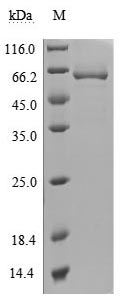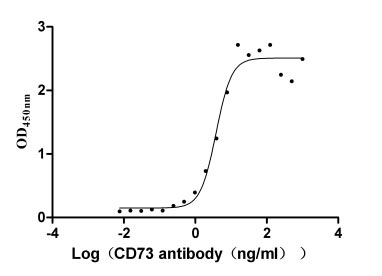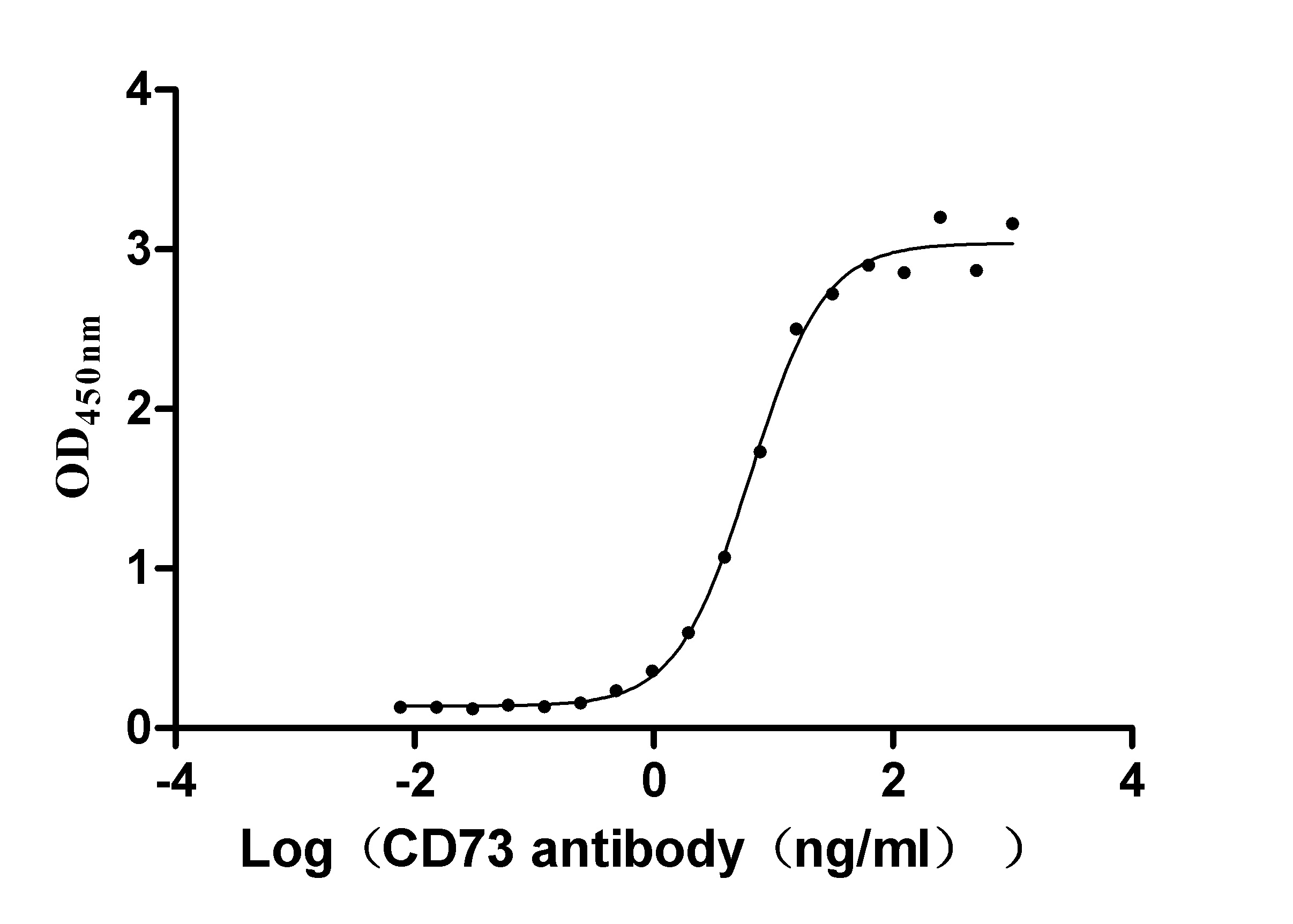This recombinant human 5'-nucleotidase (NT5E/CD73) protein, spanning residues 27-549 and expressed in mammalian cells with a C-terminal 6×His tag, exhibits >95% purity (SDS-PAGE) and low endotoxin levels (<1.0 EU/μg, LAL method). Its bioactivity is validated via ELISA, demonstrating high-affinity binding to anti-CD73 monoclonal antibodies (EC50: 3.212–4.525 ng/mL). The 6×His tag ensures efficient purification and detection while preserving structural integrity. Provided as lyophilized powder, this recombinant NT5E protein is optimized for stability and reconstitution in functional studies. Mammalian expression guarantees proper glycosylation and folding, which is critical for studying NT5E's role in adenosine metabolism, immune modulation, and cancer biology. It is ideal for investigating CD73-mediated pathways in tumor microenvironments or therapeutic targeting strategies.
Human NT5E/CD73 is an essential enzyme predominantly found on the external surface of the plasma membrane of various cell types. It is tethered to the membrane via a glycosyl-phosphatidylinositol (GPI) anchor and catalyzes the hydrolysis of extracellular adenosine monophosphate (AMP) to adenosine, playing a crucial role in purinergic signaling and modulating various physiological functions [1][2][3]. As a rate-limiting enzyme in the adenosine signaling pathway, NT5E contributes to the regulation of biological processes such as immune responses, inflammation, and cellular signaling, making it a subject of research interest in various medical fields, particularly oncology and immunology [4][5][2].
The enzymatic function of NT5E facilitates the conversion of AMP to adenosine, a nucleoside with significant effects on cellular communication and immunoregulation [6]. Elevated levels of extracellular adenosine can inhibit T-cell activation, promoting immune evasion in cancer and contributing to an immunosuppressive tumor microenvironment [6][7]. This immunosuppressive role has been well-documented, particularly in diseases such as cancer, where CD73 expression is often upregulated, correlating with poor prognosis and tumor progression [4][8][9]. The inhibition of CD73 is currently being explored as a therapeutic strategy to enhance anti-tumor immunity [10][11][12].
In addition to its enzymatic roles, NT5E is involved in broader cellular functions, including apoptosis and cell proliferation. For instance, in cancers such as glioblastoma, inhibition of ecto-5'-nucleotidase activity has been shown to reduce tumor cell proliferation, reinforcing its significance beyond mere nucleotide metabolism [13][14]. Furthermore, NT5E's interactions with the extracellular matrix (ECM) highlight its dual function as both an enzyme and a potential receptor, illustrating its complex role within the cellular microenvironment [2][14].
Given its integral role in various physiological and pathological processes, NT5E continues to be an attractive target for therapeutic intervention, particularly in cancer treatments aiming to disrupt the immunosuppressive effects mediated by adenosine signaling [5][10]. Ongoing research is even focused on identifying NT5E inhibitors capable of reversing tumor-mediated immunosuppression and improving patient outcomes [2][11][14].
References:
[1] N. Sowa, M. Voss, & M. Zylka. Recombinant ecto-5′-nucleotidase (cd73) has long lasting antinociceptive effects that are dependent on adenosine a1receptor activation. Molecular Pain, vol. 6, 2010. https://doi.org/10.1186/1744-8069-6-20
[2] P. Sun, X. Zheng, & X. Li. The effects of cd73 on gastrointestinal cancer progression and treatment, Journal of Oncology, vol. 2022, p. 1-8, 2022. https://doi.org/10.1155/2022/4330329
[3] M. Hoolwerff, M. Tuerlings, et al. Identification and functional characterization of imbalanced osteoarthritis-associated fibronectin splice variants, Rheumatology, vol. 62, no. 2, p. 894-904, 2022. https://doi.org/10.1093/rheumatology/keac272
[4] T. Jiang, X. Xu, et al. Comprehensive evaluation of nt5e/cd73 expression and its prognostic significance in distinct types of cancers. BMC Cancer, vol. 18, no. 1, 2018. https://doi.org/10.1186/s12885-018-4073-7
[5] J. Jakobsen, L. Laursen, et al. Mutant cebpa directly drives the expression of the targetable tumor-promoting factor cd73 in aml. Science Advances, vol. 5, no. 7, 2019. https://doi.org/10.1126/sciadv.aaw4304
[6] R. Shrestha, P. Prithviraj, et al. Monitoring immune checkpoint regulators as predictive biomarkers in hepatocellular carcinoma. Frontiers in Oncology, vol. 8, 2018. https://doi.org/10.3389/fonc.2018.00269
[7] J. Xiang, C. Liu, Q. He, P. He, & W. Dong. Comprehensive analysis of immunogenic cell death associated genes expression, tumor microenvironment, and prognosis in hepatocellular carcinoma. Frontiers in Pharmacology, vol. 14, 2023. https://doi.org/10.3389/fphar.2023.1122011
[8] P. Serafin, M. Popęda, et al. Knock-out of cd73 delays the onset of hr-negative breast cancer by reprogramming lipid metabolism and is associated with increased tumor mutational burden. Molecular Metabolism, vol. 89, p. 102035, 2024. https://doi.org/10.1016/j.molmet.2024.102035
[9] M. Posta and B. Győrffy. Analysis of a large cohort of pancreatic cancer transcriptomic profiles to reveal the strongest prognostic factors. Clinical and Translational Science, vol. 16, no. 8, p. 1479-1491, 2023. https://doi.org/10.1111/cts.13563
[10] N. Biswas, M. Rodríguez‐García, et al. Effect of tenofovir on nucleotidases and cytokines in hiv-1 target cells. Plos One, vol. 8, no. 10, p. e78814, 2013. https://doi.org/10.1371/journal.pone.0078814
[11] N. Sunaga, D. Shames, et al. Knockdown of oncogenic kras in non–small cell lung cancers suppresses tumor growth and sensitizes tumor cells to targeted therapy. Molecular Cancer Therapeutics, vol. 10, no. 2, p. 336-346, 2011. https://doi.org/10.1158/1535-7163.mct-10-0750
[12] F. Wirsdörfer, S. Leve, et al. Extracellular adenosine production by ecto-5′-nucleotidase (cd73) enhances radiation-induced lung fibrosis. Cancer Research, vol. 76, no. 10, p. 3045-3056, 2016. https://doi.org/10.1158/0008-5472.can-15-2310
[13] W. Chang, M. Tsai, S. Jian, C. Sheu, & P. Kuo. Systematic analysis of transcriptomic profiles of copd airway epithelium using next-generation sequencing and bioinformatics. International Journal of Chronic Obstructive Pulmonary Disease, vol. Volume 13, p. 2387-2398, 2018. https://doi.org/10.2147/copd.s173206
[14] R. Wang, Y. Wang, et al. Cd73 blockade alleviates intestinal inflammatory responses by regulating macrophage differentiation in ulcerative colitis. Experimental and Therapeutic Medicine, vol. 25, no. 6, 2023. https://doi.org/10.3892/etm.2023.11972






